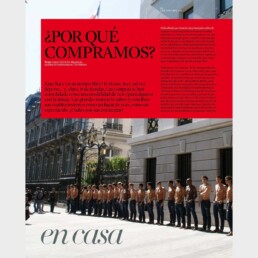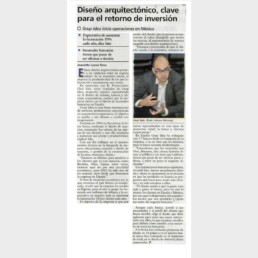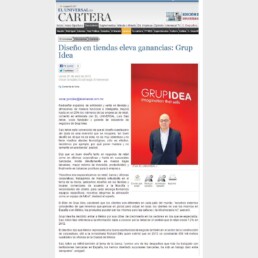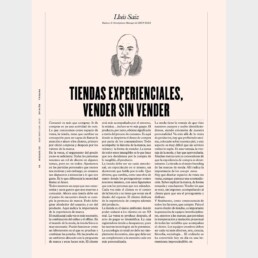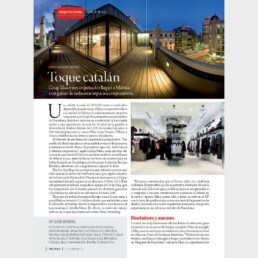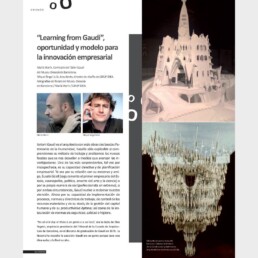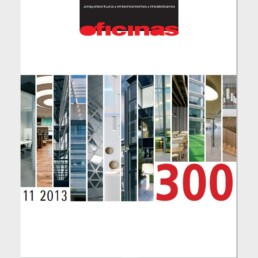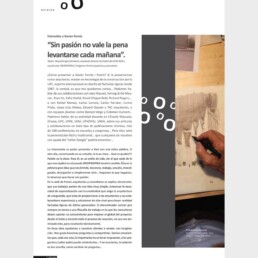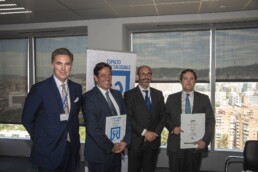The financier- Grup Idea starts operations in Mexico
Interview by Lluis Sáiz on the arrival of Grup Idea to Mexico.
El Universal - Design in high-profit stores: Grup Idea
Interview with Lluis Saiz, at Universal de México, about how design improves company numbers.
Experiential stores, sell without selling
Opinion article by Lluis Saiz published in the magazine Modaes.es
Antoni Gaudí: Opportunity and model for business innovation
Antoni Gaudí is the architect with the most works declared World Heritage, a feat that can only be explained if we understand his working method and analyse the new facets that are revealed to us as research progresses. One of the most surprising, perhaps because it is unsuspected, is his managerial and business planning skills.
Whether because of his relationship with his patron and friend, Eusebi Güell (surely the first businessman in Spain, cosmopolitan, politician, lover of art and science) or because of his own way of being (extreme perfectionist), or because of both circumstances, Gaudí once again claims our attention. This time for his ability to implement work processes, standards and guidelines; to control material resources and their stock; to manage human capital and its optimal productivity; and to establish safety, quality and hygiene standards.
Original article published in spanish in AFL magazine by Marià Marín i Torné, historian and curator of the "Gaudí Workshop" space at the Museu Diocesà de Barcelona and Miquel Àngel Julià Hierro, architect and design director of GRUP IDEA. Read the full article (in spanish) by clicking on 'Download the publication'.
No. 300 OFFICES
We have to congratulate ourselves. We already have in our hands the nº 300 of the magazine OFFICES. We look at it, we smell ... And that smell so characteristic of a new impression (and new contents), that we love so much, reminds us that these days celebrate its 45th anniversary.
We must remember that the concept of the "modern office" is in itself a relatively new "invention" of no more than 100 years. It was born as a byproduct of the factory, to gradually emancipate itself from it. For that reason, for me and for many, OFFICES is that tool, to which every architect goes in search of references, past and present, in order to try to build a better future.
The present is, was and will be changing. Evolution is not a circle that ends where it begins, but it is a growing spiral, with certain specific revolutions. As Steve Jobs said, "You can not connect the dots looking to the future; you can only connect them by looking to the past. "
In the 19th century, the typewriter, the telegraph, the elevator, the gas lighting, ... marked a radical change in the different work processes ... All of them we have overcome. Let's see what has changed in recent times, and especially at what speed: Internet, email, mobile telephony, wifi, social networks, whatsapp ...
The future of the office depends on its own past and present, on us as technicians, on customers, on users, on society, on new technologies, on manufacturers, on new professional profiles, on the media , of the new organizations and above all of the new work methodologies.
Increasingly, industrial production is outsourced and, therefore, it moves away from the heart of companies. The separation between DESIGNED IN and MADE IN increases. But, on the other hand, the services that these contribute to the users, become more important. Designing offices, more and more, is knowing how to tell a story. Therefore, the offices, initially marginal, are now the soul of companies.
In the virtual world, on Facebook, Linkedin, ..., we all have an "avatar". But even so, our real self needs to be related. Therefore, at present, corporate offices are the best symbol of the company, a space for interaction of people and learning. It is there, and not elsewhere, that we can share and seek the "cross-fertilization of ideas".
Society has changed, access to information, networking, we are totally hyperconnected .... Now more than ever, it is important to analyze sociologically the link between individual behavior and work, with the collective. The new work spaces give service to a new community formed by individuals that interrelate.
If in the present we tend to companies with liquid organizational structures, which have lost their pyramidal hierarchies, all this must finally be transferred to a new office architecture.
The value of the companies resides in the people, in the talent of the same, but above all in how knowledge is shared among them. It is the so-called "knowledge economy". A few years ago we talked about bringing and retaining talent, today we talk about connecting it. It is no longer necessary to bring talent, but to attract it. You can attract talent and customers located km away. With new technologies, distances are no longer physical, but only mental.
Google, Facebook and then others, have copied implementation schemes similar to the university ones. Coworking centers know this well and companies now imitate their "format". We must think that the coworking that have proliferated so much in recent times, would exist with and without crisis. They are not a way to lower fixed costs, but a new way of working and relating.
But the time has come for us to innovate even more in the world of the office. We only innovate if we do what we imagine. Let's do it with OFFICES! Let's design the office of the future!
We could now speak of co-design, of glocal design, of lateral thinking, of design thinking, ..., but this is already another story.
Miquel Àngel Julià, architect
Design Director of GRUP IDEA
The mission of 'showrooming'
Increasingly the function of a commercial store or an office is to tell a story that captures the customer; the sale will come later.
By Miquel Àngel Julià Hierro *
In the current global economic and social context, the use of innovation from a strategic approach is key to guarantee competitiveness and fundamental in any new corporate environment.
In retail (or retail) the most innovative proposals are observed. Brands are redefining pre-established codes and generating new forms of interaction with customers. And all this does not only happen in the commercial sphere, but it also expands to other sectors, among others in its own corporate offices.
Retail itself is a communication tool for brands, capable of generating memorable and unique experiences for visitors. Increasingly, the purpose of the stores is not to sell, but to tell a story.
The purchase as a final goal may occur later and elsewhere. What is it but the 'showrooming'? This is a new fashion that brings the online to the offline and that does not allow one to exist without the other. It consists in being able to observe, touch and test a product in a physical store, and then buy it online.
Interview with Xavier Ferrés
How to present Xavier Ferrés i Padró? If we introduce you as an architect, master in construction technology by the UPC, international expert in designing light facades since 1987, the truth is that we fall short ... We can talk about his collaborations with Jean Nouvel, Herzog & De Meuron, Toyo Ito, Zaha Hadid, David Chipperfield, Richard Rogers, ... or with Rafael Moneo, Carlos Lamela, Carlos Ferrater, Carme Pinós, Josep Lluis Mateo, Eduard Gascón and TAC arquitectes, or with young teams like Barozzi-Veiga and Colomer-Dumont ... We can talk about his teaching activity in L'Escola Massana, Elisava, UPC, UPM, UEM, UPV / EHU, UNEA, about his articles and collaborations in all kinds of technical publications, more than 100 conferences in schools and congresses ... But this would be easy and traditional presentation ... that any of us with the help of "Mr. Google", could find ...
The interesting thing is to be able to present Xavi with a single word. The other day, talking in his studio, I had it clear ... Xavi is passion!
Passion is the key. For him, it is a way of life, without which nothing that he explained to us in the past IDEAPIKAPIKA would make sense. This is the first great idea that he gave us, teaching, work, study, research, dissemination or simply living ... Whatever we do, we have to do it with passion.
On the website of Ferrés architects and consultants, it is clearly explained that their work starts from a very simple idea, connecting the need for specialization with the creativity required by avant-garde architecture, which tries to provide architects and their collaborators with experience and solutions of high level to make real light facades of last generation. The common denominator always revolves around a work philosophy in which the consultants must contribute their knowledge, to improve the overall project, from the beginning and throughout the creation process, not once finished, to solve it technically .
In Grup Idea we help our clients to sell with imagination. We like to ask questions and share them. We are aware that, more and more, the important thing is not to have answers, but questions and to know who can answer them ... And sometimes, the solution is as simple as changing the question ...
With this starting point in common, Xavier helped us to think and reflect on a series of concepts about technique, consultancies and ways of projecting, which too many times we take for granted. On this occasion and in the hands of AFL, we interviewed him again to remember those ten ideas without an answer.
"10 IDEAS without an answer. The evolution of the facade as an excuse "
by Xavier Ferrés i Padró.
Edition held at: Arpa Design Center Barcelona, June 20, 2013
IDEAPIKAPIKA is an original traveling event organized by GRUP IDEA. Mix a networking meeting, preceded by presentations and relevant topics, with a tasty pikapika that culminates the act in question. Each IDEAPIKAPIKA is celebrated in an emblematic location.
MAJH: When you project, do you care more about the questions, the ideas, or the answers themselves?
XFiP: I get the feeling that we usually act with preconceived ideas and really think very rarely carefully. Our main problem is that we do not reflect deeply on the origin of the project process and we tend to act. I think that we should be creative not only with the answers to design conflicts, but we should be creative in the approaches. This way we will avoid immediate answers and the preconceived idea of the final result of what we are proposing.
MAJH: Of the "less is more" of Mies, you like to expand the concept by saying that "everything that does not add up".
XFiP: In the "moments of exuberance" already gone, we have been adding elements and accessories to the projects. On many occasions juxtaposed to be even contradictory. Because a chain of good ideas does not always result in a good final idea. By adding components, we can be subtracting efficiency and disturbing the essence of the elements and systems. Because building, the order of the factors does alter the product.
MAJH: We've heard you explain a curious relationship between living beings and envelopes. The "Maslow Pyramid" is a psychological theory that hierarchizes human needs that argues that as the most basic needs at the bottom of the pyramid are met, we develop the needs and desires of higher levels at the top of the pyramid. . How do you transfer this theory to the world of the façade?
XFiP: Abraham Maslow, studied the basic needs of man and the order with which they had to cover, in order from bottom to top, from the base to the top vertex of a pyramid, the five levels on which his proposal is divided are: Physiology > Security> Affiliation> Recognition> Self-realization. These concepts can easily be applied in the same terms on the facades of our buildings:
As basic physiological needs: Ventilation, light, air and water tightness, thermal and acoustic insulation, solar protection, functionality, stability.
Those related to safety could have their equivalent in: Durability, resistance to fire, physical aggression, resistance to natural phenomena (earthquake, tornadoes, etc.), active and passive safety.
Identity, correct ergonomics, efficiency, proper use, utility and conventional architecture solutions would have to do with the third level, affiliation.
The next level, that of "recognition", is often given by the uniqueness of the building or by the author himself. The recognition by others, is achieved with originality and individuality. It is the architecture of the author, architecture that is sometimes rewarded, which means innovation, contribution or vanguard, exceeding the previous level of "affiliation". We began to make architectures recognizable by its author, for its quality, perhaps because of its meaning.
The last step of the pyramid that of self-realization is very complex to achieve. Only those avant-garde architectures that have brought us innovation in concepts or technology would reach it. Sometimes they are recognized architectures or by a "stamp" or by a "prize" even to the author himself, to his career or to the concrete building. Self-realization is equivalent to the recognition of contributions through work already built, which demonstrates a combination of qualities such as talent, vision of the future and commitment to the quality of construction, society and the environment, all through the Art of Architecture. Really hard to reach.
In many occasions when projecting, especially the facades, we alter the order of priorities and the whole is destabilized, we try to build to obtain the recognition of others without a solid base, we seek to signify from the form without ensuring the benefits of more basic levels. To reverse the priorities is to bet on the problem instead of solving it. The parallelism between humans and their buildings, the needs to be covered and their relative importance is very clear. Everything is a matter of criteria.
MAJH: You comment that the projects are not big or small, complex or simple, that only the work philosophy varies. What would be the key phases of a project?
XFiP: For years we have approached them with the same methodology, from the most conceptual phases to the precision of the technical detail, that is, from the initial idea, the architectural concept, the concept of the envelopes, the definition of the systems, the concretion of materials and products and the development of constructive details. Thus we can finish the phase of the execution project with the construction of the prototypes, which are, at the same time, the first step of the material execution phase.
The progress of the process is never linear since the periods of reflection, verification and decision have continuous come and go. If we work in an orderly manner and if the process is coherent, we can correct and move forward, because we know how we have reached that point. Improving results is not a random process, because with a method, errors are usually the evidence of the limit of what is possible.
MAJH: It seems that we move slowly, what are the milestones of the technique in the last 25 years?
XFiP: At the present time the construction technology evolves faster than it seems, although frankly I have not been able to find 25 milestones of the technique in the last 25 years, that are true contributions to the systems. We are talking about some examples of profiles with thermal break, double and triple glazing, structural silicones, modular construction, double skin facades, reformulation of materials such as stretched metal or stainless steel meshes ....
Actually there is a greater evolution in the performance of the components than the systems. This is logical if we consider that durability in construction is a very important variable and the process from innovation to application has increasingly a complex development, with verification, validation, testing, standardization, homologation, marketing until the application on site .
MAJH: We learn from technique, from technicians, from reality ... How is all this domesticated?
XFiP: For me there is only one solution ... Drawing to understand, learn and explain. Drawing by hand, is a very different way of perceiving things, explaining the components and giving them function. Reflecting with paper and pencil we stop being simply observers and we will participate in the understanding of objects and spaces. The objects are more than 2D images and we get to understand their operation and contribution to the system, we will understand what each of the pieces are for and how they work. It is not necessary to be a good draftsman, it is important that the drawing understands and contributes to each scale the variables so that the whole is understood, a drawing will be well explained and makes clear that the technique and the form are the same thing.
MAJH: Is the curtain wall the great milestone of modern architecture?
XFiP: Compared with light facades, the conventional façade is structural and supportive, shelters, protects, contributes to the thermal inertia of the building, is stable and durable. The hollows with size, proportion, distribution that with the appropriate ornamentation order and hierarchize the elevations. The games of massifs and hollows, the shadows and the different well composed elements make the façade perfectly understood. On the other hand, the curtain wall because of the accessories and accessories that we talked about a while ago, has been trivialized and is simply an enclosure that passes in front of the structure, with a collection of objects that are rarely well ordered and it turns out that we have all believed, it seems that the technique is enough to build and make architecture ... The facades often have their own logic and discourse and ignore what happens beyond the limit of the interior, we could say that the curtain wall killed the facade, or at least it took her to the ICU because of the excesses and overacting.
MAJH: What do you think of the architectural icons?
XFiP: The answer has to do with the previous question, the icons without materiality are images without a soul. Currently there are buildings that are pure packaging, they are pure boast, they are simple packages, they are complexity to signify, they are pure vanity. The soul has to do with the user, with the place, with the author, with society, with the city, with the environment, with the future ... Something as elementary as good guidance, how to rationalize constructive solutions, how to work materials , the unions, the colors, the textures, the habitability or the comfort ... they are themes that are forgotten in order to make more and more singular compositions trying to individualize and to be unfortunately "original".
Not only geometries and combinations of supposedly technical and high-risk solutions are pure architecture. Given the case, our obligation is to rationalize them, detail them, make them constructible, understand them looking for the precise feeling between materials and architecture, in short to be efficient in all orders.
MAJH: There is a tendency that seems to dominate the avant-garde proposals, the current façade is often information support. What's your opinion about it?
XFiP: The facades have been, are and will be information supports, this is not new. The buildings are illuminated, from within, from outside and that allows to establish a dialogue with the city. The buildings explain stories by applying different technologies and in many cases the information is superimposed on the façade using it as a support. If we think of cathedrals, they already explained stories with light and color day and night. We are modern and in the background we continue to do the same, but with less criteria and we are literally lining buildings to support all kinds of lamps and screens that rarely contribute to pacifying the environment. The Shibuya models in Tokyo, Times Square in New York, Picadilly in London, the profiles of Hong Kong or Shanghai ... are some very interesting examples of what can be done and what in some cases can be avoided. Saturation, pollution, overinformation, distortion ... a little bit of each but in moderation.
MAJH: Speaking of technology and limits Do you consider that history is therefore cyclical and repeated?
XFiP: Of course, with the same arguments as always, technology, large format, transparency, lightness, limit of the possible ... Two examples separated 80 years such as the Garage Marbeuf de Paris, designed by Laprade and Bazin for Citroën in 1928 and the Apple Store of the 5th Avenue of New York of Bohlin Cywinski Jackson are projects of the maximum formats with a metal structure in one case and glass in the other, which showed a great interior vacuum in which cars were exposed in a case and in the other all the objects of desire related to electronics and communication. Axes of the vanguard of technology in each of the moments, history repeats itself. In 2008, Mr. Jobs, with the Apple Store does the same. In both cases, the interest is the same, being the spearhead and absolute vanguard of construction technology and of overcoming by playing with the same elements, the only difference is that the New York Apple cube has been redesigned and built After 4 years with greater formats, greater transparency, fewer components, more risk, technological development that will be applied in the immediate future to other constructions ... In the background we talk about formula 1. They say that Jobs said that if you had doubts and you questioned if it was worth the effort, if that small advance compensated ... you were out of the company ...
MAJH: Now what do we do?
XFiP: To finish 10 ideas to maintain throughout the design and construction process, in addition to curiosity, we must observe with a critical spirit and not have any fear to experiment and get confused.
In the end a little Rationality, Order, Methodology, Reflection, Self-demand, Transdisciplinarity, Sensibility, Integration, R & D at the right moment and Passion.
Because without passion it is not worth getting up every morning.
More information:
www.ferresarquitectos.com
Celebrating the SPATIUM Seal release to Torre Auditori in Barcelona with our partner SMDOS.
Torre Auditori (BcnFira District) of Iberdrola Inmobiliaria has been awarded the Spatium seal: "Safe and Healthy Building"
This makes it the first office building in Barcelona to receive the spatium seal. The achievement of this mention certifies Torre Auditori as the safest, healthiest and most responsible building in Barcelona, in addition to obtaining the category: EXCELLENT. Mr. Manuel Sanz, General Manager of SMDos, presented the plaque to Mr. Emilio Sánchez Castellano, CEO of Iberdrola Inmobiliaria. The international certifying body IMQ Ibérica, which certifies the seal of conformity, was represented by Mr. Alejandro García, general manager of the company.
The SPATIUM Seal of Conformity is structured into four categories (Good, Very Good, Excellent and Exceptional) and is based on an analysis of 14 families of risks and around 200 control items, which SMDos carries out together with its specialized partners (JG Ingenieros, GrupIDEA, Cardioguard, Global Finanz or Ampell, among others) and which is guaranteed by the international certifier IMQ Ibérica.
The Seal, which is renewed annually to reflect changes in both requirements and regulations and in the conditions of the certified facilities themselves. That is to say, it compiles a wide range of legal norms, together with conduct, values and improvements in this area. Clearly oriented towards the user, it has three main objectives, which are;
- To objectively demonstrate the guarantees to the user of the property in this area - creating safer, healthier and "friendly" classroom environments.
- Promote and verify good practices in the exploitation of real estate assets (from Health and Safety).
- Y Achieve a reduction in the potential risks to the users of these spaces.
At the same time, an exclusive differentiating element is added to the spaces, in order to reinforce the brand image of the building through an innovative Conformity Seal.
Source: SMDos
